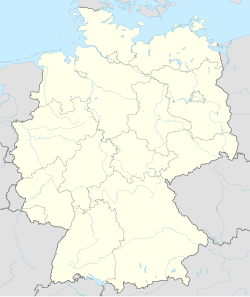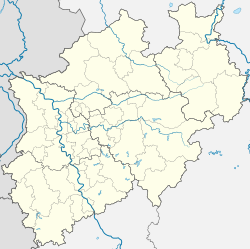Mülheim, officially Mülheim an der Ruhr (Low German: Mölm; Kölsch: Müllem; German pronunciation: [ˈmyːlhaɪm ʔan deːɐ̯ ˈʁuːɐ̯] ) and also described as "City on the River", is a city in North Rhine-Westphalia in Germany. It is located in the Ruhr Area between Duisburg, Essen, Oberhausen and Ratingen. It is home to many companies, and two Max Planck Institutes.
Mülheim an der Ruhr | |
|---|---|
 View of the city centre | |
| Coordinates: 51°25′39″N 06°52′57″E / 51.42750°N 6.88250°E | |
| Country | Germany |
| State | North Rhine-Westphalia |
| Admin. region | Düsseldorf |
| District | Urban district |
| Subdivisions | 3 districts, 9 boroughs |
| Government | |
| • Lord mayor (2020–25) | Marc Buchholz[1] (CDU) |
| Area | |
• Total | 91.26 km2 (35.24 sq mi) |
| Highest elevation | 153 m (502 ft) |
| Lowest elevation | 26 m (85 ft) |
| Population (2023-12-31)[2] | |
• Total | 173,255 |
| • Density | 1,900/km2 (4,900/sq mi) |
| Time zone | UTC+01:00 (CET) |
| • Summer (DST) | UTC+02:00 (CEST) |
| Postal codes | 45468–45481 |
| Dialling codes | 0208 |
| Vehicle registration | MH |
| Website | www.muelheim-ruhr.de |
Mülheim an der Ruhr received its town charter in 1808, and 100 years later the population exceeded 100,000, making Mülheim officially a city. At the time of the city's 200th anniversary with approximately 170,000 residents, it was counted among the smaller cities of Germany.
Geography
editGeographical location
editMülheim an der Ruhr is located to the southwest of Essen in the Ruhr valley.[3]
Geology
editThe northern foothills of the Rhenish Massif are characterised by the distinctive rock formation of the bare mountain slopes through which run coal-bearing layers which formed during the carboniferous period. Here the Ruhr cuts more than 50 meters deep into this Mittelgebirge. This natural erosion partly uncovered these mineable black coal deposits, which enabled their exploration and extraction using adits. However, the coal-rich layers became ever deeper as one progressed northward, which required setting up mines to extract the black coal. In contrast, the broad bayou (dead arm of a river) of Styrum borough is characteristic of the features of the Lower Rhine Plain.[4]
| Rank | Nationality | Population (31.12.2022) |
|---|---|---|
| 1 | Turkey | 4,807 |
| 2 | Syria | 2,910 |
| 3 | Serbia | 1,594 |
| 4 | Iraq | 1,423 |
| 5 | Poland | 1,357 |
| 6 | Ukraine | 1,306 |
| 7 | Romania | 1,243 |
| 8 | Italy | 1,149 |
| 9 | China | 1,017 |
| 10 | Kosovo | 964 |
Transport
editPolitics
editMayor
editThe current mayor of Mülheim is Marc Buchholz of the Christian Democratic Union (CDU) since 2020. The most recent mayoral election was held on 13 September 2020, with a runoff held on 27 September, and the results were as follows:
| Candidate | Party | First round | Second round | |||
|---|---|---|---|---|---|---|
| Votes | % | Votes | % | |||
| Marc Buchholz | Christian Democratic Union | 16,479 | 25.4 | 27,716 | 56.9 | |
| Monika Griefahn | Social Democratic Party | 16,385 | 25.3 | 20,984 | 43.1 | |
| Wilhelm Steitz | Alliance 90/The Greens | 10,178 | 15.7 | |||
| Horst Bilo | Independent | 5,394 | 8.3 | |||
| Jürgen Abeln | Independent | 4,907 | 7.6 | |||
| Andreas Brings | Die PARTEI | 3,940 | 6.1 | |||
| Alexander von Wrese | Alternative for Germany | 3,920 | 6.0 | |||
| Amrei Debatin | Free Democratic Party | 1,853 | 2.9 | |||
| Jochen Dirk Hartmann | Independent | 945 | 1.5 | |||
| Martin Ulrich Fritz | Civic Awakening Mülheim | 808 | 1.2 | |||
| Valid votes | 64,809 | 98.7 | 48,700 | 98.6 | ||
| Invalid votes | 879 | 1.3 | 679 | 1.4 | ||
| Total | 65,688 | 100.0 | 49,379 | 100.0 | ||
| Electorate/voter turnout | 130,571 | 50.3 | 130,561 | 37.8 | ||
| Source: State Returning Officer | ||||||
City council
editThe Mülheim city council governs the city alongside the mayor. The most recent city council election was held on 13 September 2020, and the results were as follows:
| Party | Votes | % | +/- | Seats | +/- | |
|---|---|---|---|---|---|---|
| Christian Democratic Union (CDU) | 16,970 | 26.3 | 0.9 | 14 | 1 | |
| Alliance 90/The Greens (Grüne) | 15,097 | 23.4 | 12.4 | 13 | 7 | |
| Social Democratic Party (SPD) | 13,765 | 21.3 | 10.2 | 12 | 5 | |
| Alternative for Germany (AfD) | 4,629 | 7.2 | 1.9 | 4 | 1 | |
| Mülheimer Citizens' Initiative (MBI) | 3,043 | 4.7 | 5.4 | 3 | 2 | |
| Free Democratic Party (FDP) | 3,003 | 4.7 | 0.7 | 3 | ±0 | |
| Die PARTEI (PARTEI) | 2,866 | 4.4 | New | 2 | New | |
| The Left (Die Linke) | 1,751 | 2.7 | 1.4 | 1 | 1 | |
| We From Mülheim (WIR) | 1,560 | 2.4 | 1.0 | 1 | ±0 | |
| Civic Awakening Mülheim (BAMH) | 1,173 | 1.8 | New | 1 | New | |
| Alliance for Education (BüfBi) | 424 | 0.7 | 0.3 | 0 | 1 | |
| Independents | 226 | 0.4 | – | 0 | – | |
| Valid votes | 64,507 | 98.3 | ||||
| Invalid votes | 1,144 | 1.7 | ||||
| Total | 65,651 | 100.0 | 54 | ±0 | ||
| Electorate/voter turnout | 130,571 | 50.3 | 0.0 | |||
| Source: State Returning Officer | ||||||
Twin towns – sister cities
editEducation and research
editMülheim is home to two Max Planck Institutes, a university campus, and various other educational and scientific institutions.
- Max Planck Institute for Coal Research
- Max Planck Institute for Chemical Energy Conversion
- Ruhr West University of Applied Sciences, main campus
- IWW Water Centre, water research institute of the University of Duisburg-Essen
- 39 Schools, among them 22 primary schools, 12 general secondary schools, 2 vocational schools, 1 Waldorf school, and 2 special schools
Companies
edit- Plus (founded 1972), a supermarket chain
- Tengelmann (founded 1867), a holding company
- Aldi Süd (founded 1946, split in two parts in 1960, renamed to Aldi Süd in 1962), a discount supermarket chain
- Harke Group, formerly Syntana (founded 1965), a chemical and plastics distributor
- Europipe GmbH (founded 1991), main manufacturer of seamless pipes for the Nord Stream pipelines
Sports clubs
edit- 1. FC Mülheim (founded 1923), a football club
- VfB Speldorf (founded 1919), a football club
- HTC Uhlenhorst Mülheim (founded 1920), a field hockey club
People
edit- Wilhelm Rittenhausen (1644–1708), founder of the first paper mill in North America
- Gerhard Tersteegen (1697–1769), Reformed religious writer
- Carl Arnold Kortum (1745–1824), physician, writer and poet
- August Bungert (1845–1915), opera composer and poet
- Wilibald Nagel (1863–1929), musicologist
- Hugo Stinnes (1870–1924), industrialist and founder of the German People's Party
- Fritz Thyssen (1873–1951), industrialist associated with the Nazi Party
- Carl Otto von Eicken (1873–1960), otorhinolaryngologist
- Heinrich Thyssen (1875–1947), German-Hungarian entrepreneur and art collector
- Arthur Kaufmann (1888–1971), painter
- Walter Hartmann (1891–1977), general of artillery in World War II
- Dagmar Mühlenfeld (born 1951), mayor of Mühleim
- Otto Pankok (1893–1966), painter, printmaker and sculptor
- Otto Roelen (1897–1993), chemist
- Karl Ziegler (1898–1973), chemist, Nobel Prize winner
- Clärenore Stinnes (1901–1990), car racer, the first person to circumnavigate the world by automobile
- Werner Best (1903–1989), jurist, police chief and Nazi leader
- Carl Balhaus (1905–1968), actor and director
- Ferdinand aus der Fünten (1909–1989), SS-Hauptsturmführer, war criminal
- Fritz Buchloh (1909–1998), footballer
- Günther Smend (1912–1944), officer and a resistance fighter involved in the July 20 Plot to assassinate Adolf Hitler
- Johannes Bölter (1915–1987), German Army tank commander during World War II
- Karl Albrecht (1920–2014), entrepreneur, Aldi founder
- Theo Albrecht (1922–2010), entrepreneur, Aldi founder
- Wilhelm Knabe (1923–2021), ecologist, pacifist, civil servant, politician and co-founder of the Green Party in Germany
- Wim Thoelke (1927–1995), TV entertainer
- Hermann Bottenbruch (1928–2019), mathematician and computer scientist
- Jürgen Sundermann (born 1940), football player and manager
- Hans Walitza (born 1945), football player and manager
- Rudolf Seliger (born 1951), footballer
- Bodo Hombach (born 1952), politician (SPD)
- Monika Griefahn (born 1954), politician (SPD)
- Hans-Günter Bruns (born 1954), footballer
- Helge Schneider (born 1955), comedian, musician, author, film and theatre director and actor
- Ralph Morgenstern (born 1956), television presenter and actor
- Albrecht von Croÿ (born 1958), journalist
- Ulla Kock am Brink (born 1961), television presenter
- Hannelore Kraft (born 1961), politician (SPD) and Minister-President of North Rhine-Westphalia
- Ralf Lübke (born 1965), athlete
- Carolin Emcke (born 1967), journalist
- Willi Landgraf (born 1968), footballer
- Sven Meinhardt (born 1971), field hockey player, Olympic winner
- André Lenz (born 1973), footballer
- Lars Burgsmüller (born 1975), tennis player
- Marion Rodewald (born 1976), field hockey player, Olympic winner
- Kai Gehring (born 1977), politician
- Felix Erdmann (born 1978), rowing cox
- Simone Hanselmann (born 1979), actress
- Salih Altın (born 1987), footballer
- Bobby Gunns (born 1992), professional wrestler
- Jonathan Rommelmann (born 1994), Olympic medalist
- Stephanie Stebich (born 1966), art historian
- Rüdiger Emshoff (born 1960), maxillofacial surgeon and associate professor
Gallery
edit-
Courtyard of Schloss Broich
-
Town Hall
-
Mülheim Stadthalle
-
View to the street and tram station Aktienstraße
-
Friedrichstraße
-
Petrikirche
-
Highrise buildings in the city centre
-
Water feature in MüGa-Park
See also
editReferences
edit- ^ Wahlergebnisse in NRW Kommunalwahlen 2020, Land Nordrhein-Westfalen, accessed 19 June 2021.
- ^ "Bevölkerung der Gemeinden Nordrhein-Westfalens am 31. Dezember 2023 – Fortschreibung des Bevölkerungsstandes auf Basis des Zensus vom 9. Mai 2011" (in German). Landesbetrieb Information und Technik NRW. Retrieved 2024-06-20.
- ^ "Mülheim an der Ruhr". Encyclopaedia Britannica. Retrieved 5 December 2020.
- ^ "Mülheim an der Ruhr official website – Eine kurze Geschichte zur Geologie und zur Geographie des Stadtgebietes". (in only German) © 1998–2010 MST Mülheimer Stadtmarketing und Tourismus GmbH. Retrieved 2010-04-19.
- ^ "Mülheim an der Ruhr". Urban Rail. Retrieved 21 November 2015.
- ^ "Städtepartnerschaften". muelheim-ruhr.de (in German). Mülheim an der Ruhr. Retrieved 2021-02-27.
External links
edit- . Encyclopædia Britannica. Vol. 18 (11th ed.). 1911. p. 960.
- Official city homepage



